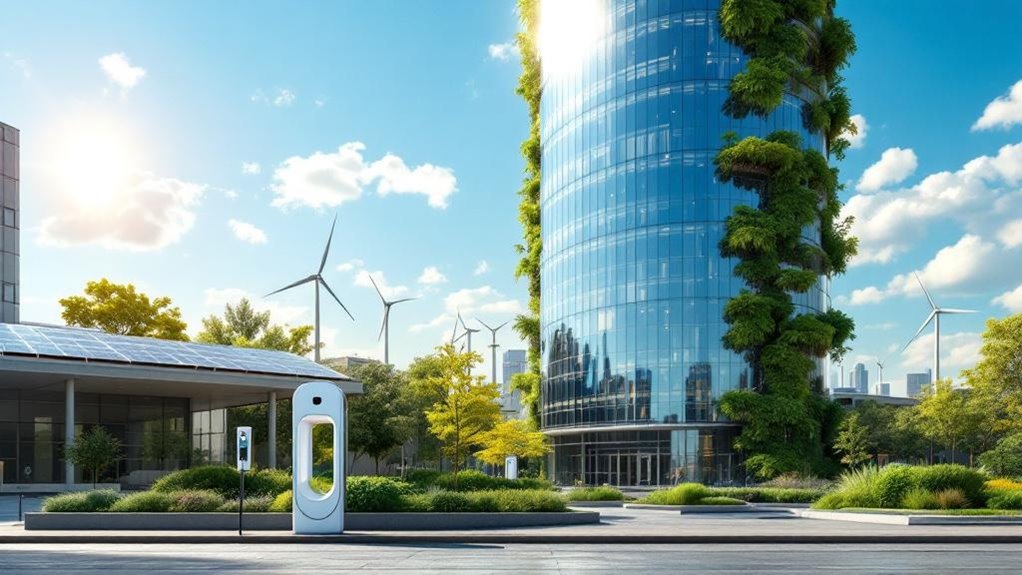Multilateral Development Banks play a central role in global climate finance by channeling and leveraging substantial funds for sustainable development initiatives. In 2023, MDBs achieved record-breaking climate finance of $125 billion, with $97.2 billion allocated to mitigation and $24.7 billion to adaptation projects, while mobilizing an additional $101 billion in private sector investments. Their strategic targets project an ambitious increase to $170 billion annually by 2030, demonstrating their expanding influence in shaping sustainable financial frameworks and climate resilience worldwide.
Understanding MDBs and Their Climate Finance Commitments

While the global response to climate change requires coordinated financial action, Multilateral Development Banks (MDBs) have emerged as pivotal institutions in channeling climate finance to developing nations and catalyzing sustainable development initiatives worldwide.
Under established MDB governance frameworks, these international financial institutions combine resources from member countries to provide grants, concessional loans, and technical assistance for climate-related projects. MDB impacts are particularly significant in their ability to leverage financial strength and risk mitigation tools, mobilizing additional private and public sector investments for climate initiatives. In 2023, MDBs achieved a record-high $125 billion in public climate finance, demonstrating their growing commitment to climate action.
MDBs leverage their financial power to unlock broader investment potential, transforming climate action through strategic funding and risk management.
Their collective commitments include ambitious targets, projecting $120 billion annually by 2030 for low- and middle-income countries, with $42 billion dedicated to adaptation projects. Working alongside the Green Climate Fund, MDBs help fulfill the Paris Agreement’s mandate for developed nations to support climate initiatives in developing countries.
These institutions operate through consensus-based decision-making processes, ensuring shared ownership and accountability in addressing global climate challenges.
Record-Breaking Climate Finance Achievements in 2023
As global climate finance reached unprecedented levels in 2023, Multilateral Development Banks achieved a historic milestone by committing $125 billion to climate-related initiatives, more than doubling their 2019 contributions. The 13th Joint Report marks a significant advancement in tracking and reporting these climate investments.
The unprecedented funding strategies demonstrated a strategic allocation between mitigation and adaptation efforts, with significant emphasis on supporting low- and middle-income economies. Public finance contributions remain essential for reducing investment risks and attracting private capital.
| Climate Finance Category | Amount (Billions) |
|---|---|
| Total Commitments | $125.0 |
| Mitigation Finance | $97.2 |
| Adaptation Finance | $24.7 |
| Private Finance Mobilized | $101.0 |
| Dual-Benefit Projects | $3.26 |
This transformative expansion of climate initiatives reflects the MDBs’ enhanced commitment to global climate action, with particular emphasis on catalyzing private sector engagement and supporting vulnerable regions. The mobilization of $101 billion in private finance further exemplifies the institutions’ capacity to leverage resources for maximum impact.
Strategic Targets and Financial Projections for 2030

Multilateral Development Banks have established ambitious climate finance targets for 2030, projecting USD 120 billion annually for low- and middle-income countries and USD 50 billion for high-income nations.
The strategic framework emphasizes substantial private sector mobilization, with MDBs aiming to catalyze USD 65 billion annually from private investors across both market segments through innovative financial instruments and blended finance approaches. The integration of concessional funding mechanisms has proven crucial for attracting private investment while addressing market barriers. Recent performance indicators show that MDBs have exceeded 2025 projections set during their initial climate finance assessment in 2019.
These extensive targets reflect an enhanced focus on regional investment distribution, with particular attention given to adaptation financing for climate-vulnerable regions, earmarking USD 42 billion for low- and middle-income countries and USD 7 billion for high-income territories.
Ambitious Finance Growth Plans
Through ambitious strategic planning and coordinated efforts, Multilateral Development Banks (MDBs) have established substantial climate finance growth targets projected to reach USD 170 billion annually by 2030, encompassing both high-income and developing nations.
The collective MDB investment strategies demonstrate unprecedented commitment to climate action, despite finance growth challenges in implementation. MDBs aim to mobilize USD 65 billion from private sector investments to support climate initiatives across all income levels. Green bonds have emerged as a key financing instrument to help MDBs achieve their ambitious climate targets.
Key financing targets include:
- USD 120 billion annual climate financing for low- and middle-income countries, with USD 42 billion dedicated to adaptation
- USD 50 billion annual climate financing for high-income countries, including USD 7 billion for adaptation measures
- Asian Development Bank’s USD 100 billion commitment for 2019-2030, with 50% directed to climate initiatives
- European Investment Bank’s mandate to allocate over 50% of operations to climate action and environmental sustainability by 2025
Private Capital Mobilization Goals
Private sector capital mobilization stands at the forefront of ambitious MDB climate finance targets, with strategic projections aiming to catalyze USD 390 billion in annual financing by 2030.
Leading institutions have established specific mobilization strategies, with IFC targeting an 80% private capital mobilization ratio and IBRD maintaining a 25% target through 2030.
These investment frameworks are reinforced by concrete institutional commitments, exemplified by IDB Invest’s USD 3.5 billion capital increase tied directly to mobilization objectives.
Recent data shows record climate funding reached $63 billion in 2021/22, though significant gaps remain in developing nations’ financing needs.
UNCTAD estimates indicate an annual investment requirement of USD 2-3 trillion through 2030 to achieve sustainable development goals, highlighting the critical need for accelerated private capital mobilization.
While current private sector capital flows to low- and middle-income countries have shown modest growth from USD 60 billion in 2017 to USD 65 billion in 2022, enhanced operating models and structural reforms are being implemented to accelerate private sector participation and achieve the projected climate finance targets.
Regional Investment Distribution
Strategically allocating $170 billion in annual climate finance by 2030, Multilateral Development Banks have established extensive regional distribution targets that prioritize low- and middle-income countries with a projected $120 billion allocation, while designating $50 billion for high-income nations.
This strategic framework aims to address persistent regional disparities and funding gaps in climate finance accessibility. The framework leverages stable returns to attract increased private sector participation in climate-focused investments.
Key distribution metrics include:
- $42 billion annually for adaptation in low- and middle-income countries
- $7 billion designated for adaptation initiatives in high-income nations
- 60% of current climate finance ($74.7 billion) directed to developing economies
- Regional allocations aligned with emission profiles and vulnerability assessments
The framework emphasizes support for Africa, Asia, and Latin America, with particular attention to infrastructure resilience, renewable energy development, and sustainable agricultural practices in climate-vulnerable regions.
Private Sector Engagement and Investment Mobilization

Multilateral Development Banks have intensified their engagement with private sector stakeholders to accelerate climate finance mobilization, targeting an ambitious USD 65 billion in annual private investments across both developing and developed economies by 2030.
Their approach leverages innovative financing mechanisms, including blended finance and risk mitigation tools, while establishing scalable platforms to facilitate broader market participation. The implementation of hybrid-capital instruments has significantly expanded their financing toolkit for climate initiatives.
The MDBs’ strategic focus on private investment trends has yielded significant results, with direct climate finance increasing by 25% since 2023 and private sector mobilization efforts doubling within the same period.
Through systematic collaboration with governments and local financial institutions, MDBs are creating enabling environments that attract private capital while maintaining rigorous measurement and reporting standards to guarantee accountability and transparency in climate finance deployment.
Adaptation Versus Mitigation: Balancing Climate Finance Priorities
While the global climate finance landscape demands robust action on both fronts, MDBs face ongoing challenges in achieving equilibrium between adaptation and mitigation funding allocations, as evidenced by their widely varying portfolio distributions in 2023.
The divergent approaches to balancing adaptation challenges and mitigation strategies among MDBs reflect institutional priorities and operational complexities. The latest data shows that $125 billion was committed by MDBs for climate action in 2023.
- African Development Bank maintains leadership in adaptation finance at 52%, demonstrating strongest commitment to climate resilience.
- European Investment Bank heavily favors mitigation at 94%, focusing on emissions reduction initiatives.
- Asian Development Bank achieves relative balance with 43% adaptation allocation.
- Islamic Development Bank reports 30% adaptation share, indicating room for portfolio rebalancing.
These disparities underscore the necessity for standardized metrics and enhanced coordination among MDBs to optimize climate finance distribution across both adaptation and mitigation initiatives.
Regional Distribution and Country-Specific Support
Multilateral Development Banks have established a sophisticated regional distribution framework that prioritizes climate-vulnerable nations, with Sub-Saharan Africa receiving $17.24 billion and South Asia allocated $12.93 billion in 2023.
The geographic allocation methodology incorporates vulnerability assessments, institutional readiness metrics, and locally-identified climate priorities to guarantee targeted deployment of both financial and technical resources.
This regionally-tailored approach enables MDBs to build local implementation capacity while addressing specific climate challenges through customized financial instruments, evidenced by the $74.7 billion total commitment to low- and middle-income countries representing 60% of all MDB climate finance in 2023.
Targeted Assistance By Region
Through strategic regional allocation of climate finance, Multilateral Development Banks (MDBs) distributed $74.7 billion to low- and middle-income economies in 2023, with Sub-Saharan Africa receiving the largest share at $17.2 billion, followed by South Asia at $12.9 billion and the Middle East and North Africa at $5.3 billion.
Regional projects and funding challenges are addressed through targeted interventions across diverse geographical contexts, with MDBs managing both internal funds ($70.6 billion) and external resources ($4.1 billion).
- Sub-Saharan Africa prioritizes renewable energy and climate-resilient agriculture.
- South Asia focuses on flood protection and urban climate resilience.
- MENA region emphasizes water scarcity solutions and solar energy investments.
- Multi-regional projects account for $4.7 billion in cross-border initiatives.
Vulnerability-Based Funding Priorities
Four distinct vulnerability-based funding priorities guide MDBs’ climate finance allocation across regions, with the largest share of $17.2 billion directed to Sub-Saharan Africa due to its acute climate risks and development challenges.
South Asia follows with $12.9 billion in allocated funds, reflecting the region’s significant vulnerability indicators and adaptation needs, while the Middle East and North Africa receive $5.3 billion to address water scarcity and climate resilience concerns.
Multi-regional initiatives account for $4.7 billion, targeting cross-border funding challenges and shared climate vulnerabilities. This distribution pattern aligns with thorough vulnerability assessments that consider factors such as disaster risk exposure, adaptive capacity, and socioeconomic development levels, ensuring resources reach populations most susceptible to climate change impacts.
Local Capacity Building Initiatives
In response to the growing complexity of climate finance implementation, MDBs have established extensive local capacity building programs that span diverse geographic regions and development contexts.
Through strategic partnerships and targeted interventions, these institutions systematically strengthen local capabilities for climate resilience planning and project execution. The global reach of National Development Banks, with their combined $20 trillion assets, positions them as crucial partners in expanding local climate finance initiatives.
Key components of local stakeholder engagement include:
- Technical assistance programs that enhance institutional capacity for project design and implementation
- Collaborative platforms connecting national development banks with international climate funds
- Targeted support for urban climate finance initiatives, addressing the significant 92-93% investment gap
- Country-specific program tailoring that aligns with national adaptation plans and local priorities
This thorough approach enables countries to develop sustainable climate finance frameworks while building endogenous expertise for long-term resilience.
Monitoring Mechanisms and Reporting Standards
While multilateral development banks (MDBs) have greatly expanded their climate finance initiatives, the establishment of robust monitoring mechanisms and standardized reporting frameworks remains essential for ensuring accountability and tracking progress.
The Joint Climate Finance Tracking Group has implemented thorough methodologies to address monitoring challenges and adaptation complexities across institutions.
MDBs have adopted harmonized standards through the “Common Principles for Climate Mitigation Finance Tracking” and “Common Principles for Climate Adaptation Finance Tracking,” distinguishing climate-specific financing from general development funds.
MDBs utilize shared tracking principles to separate dedicated climate finance from broader development funding streams across their portfolios.
The three-step methodology for adaptation finance particularly focuses on identifying context-specific vulnerabilities and quantifying activities directly linked to climate resilience.
Annual Joint Reports provide transparent, disaggregated data on climate finance figures, project breakdowns, and sector-specific information, ensuring accessibility for stakeholders across all economies where MDBs operate.
Overcoming Implementation Barriers
Despite significant commitments from multilateral development banks to advance climate finance initiatives, persistent implementation barriers continue to impede the effective deployment and impact of climate-focused funding across developing regions.
Cities currently receive only 1% of needed climate finance while being responsible for the majority of global emissions and energy consumption.
These implementation challenges and funding gaps require systematic solutions to enhance the effectiveness of climate finance deployment.
Key barriers that demand immediate attention include:
- Substantial shortfalls in direct MDB funding for Global South projects, particularly at urban and city levels.
- Persistent allocation imbalances between adaptation and mitigation initiatives, with adaptation receiving disproportionately less support.
- Limited local institutional capacity for preparing bankable project proposals and managing implementation.
- Fragmented coordination among stakeholders, including MDBs, national governments, and local authorities, leading to delayed project execution and suboptimal resource utilization.
Future Outlook and Strategic Development
Multilateral development banks stand poised to dramatically reshape the climate finance landscape through ambitious strategic initiatives projected through 2030 and beyond.
Their collective commitment to mobilize $170 billion annually across high, middle, and low-income countries represents a transformative approach to global climate action.
A crucial goal includes closing the $4.5 trillion annual urban climate finance gap through targeted investments and partnerships.
Future innovations in financial instruments, including green bonds and sustainability-linked loans, will facilitate broader market participation and enhanced private sector engagement.
The banks’ funding strategies emphasize strategic sectoral expansion, particularly in adaptation finance, targeting $42 billion for low and middle-income countries while leveraging an additional $65 billion from private sources.
This extensive approach, aligned with Paris Agreement objectives and reinforced through COP29 commitments, positions MDBs as vital catalysts in accelerating global climate finance solutions.
Frequently Asked Questions
How Do MDBS Handle Project Failures or Underperforming Climate Investments?
Multilateral Development Banks employ extensive project evaluation systems to identify and address underperforming climate investments through systematic monitoring and intervention protocols.
When projects fail to meet objectives, MDBs implement financial restructuring measures, including fund reallocation and corrective action plans.
They also leverage partnerships with local institutions to mitigate risks, while documenting lessons learned to improve future project designs and maintain accountability through transparent reporting mechanisms.
What Criteria Determine Which Countries Receive Priority for Climate Finance Support?
Priority for climate finance support is determined through thorough climate vulnerability assessments and economic stability indicators.
Key determining factors include:
- Geographic exposure to climate risks and socioeconomic vulnerabilities in low- and middle-income countries
- National debt sustainability and financial capacity to manage funds
- Alignment with established climate action plans and NDCs
- Demonstrated commitment to measurable mitigation and adaptation outcomes
- Institutional capacity to implement and monitor climate projects effectively
This systematic approach guarantees resources reach nations with the greatest need and potential impact.
How Do MDBS Coordinate to Prevent Overlapping or Duplicate Climate Projects?
MDBs employ multiple coordination mechanisms to prevent project duplication.
Through standardized digital platforms and joint reporting systems, they maintain funding transparency across institutions.
Regular working groups facilitate project alignment by synchronizing investment pipelines and research activities.
Shared taxonomies and evaluation frameworks guarantee consistent classification of climate initiatives.
Additionally, consolidated databases and inter-institutional data sharing enable real-time visibility of ongoing and planned projects across regions and sectors.
What Happens When Countries Default on Climate Finance Loans From MDBS?
When countries default on climate finance loans, MDBs typically initiate debt restructuring processes to manage financial implications. This often includes extending repayment terms, reducing interest rates, or converting loans to more concessional arrangements.
Default consequences may include:
- Suspension of ongoing project disbursements
- Credit rating downgrades affecting future borrowing capacity
- Increased monitoring requirements for existing projects
- Potential coordination with other creditors for thorough debt workouts
- Review of eligibility for grant-based rescue packages
How Do Local Communities Participate in MDB Climate Project Decisions?
Local communities participate in climate projects through structured community engagement frameworks and participatory decision-making processes.
Key mechanisms include:
- Technical support for project design and needs assessments
- Formal consultations with local governments and community representatives
- Participation in monitoring and evaluation activities
- Input through grievance redress systems and public feedback channels
- Partnership with city networks and community organizations for implementation
These processes guarantee projects reflect local priorities and maintain accountability throughout implementation.
Conclusion
Multilateral Development Banks remain pivotal in accelerating global climate finance through strategic resource mobilization, innovative financial instruments, and targeted interventions. Their evolving role encompasses both adaptation and mitigation priorities while fostering private sector engagement. As climate challenges intensify, MDBs must continue strengthening their collaborative frameworks, enhancing transparency mechanisms, and scaling up financial commitments to meet the ambitious targets set for 2030 and beyond.
References
- https://www.worldbank.org/en/news/press-release/2024/11/12/multilateral-development-banks-to-boost-climate-finance
- https://www.eib.org/en/press/all/2024-443-multilateral-development-banks-to-boost-climate-finance
- https://www.adb.org/news/climate-finance-multilateral-development-banks-hits-record-2023
- https://www.wri.org/insights/climate-finance-progress-2025
- https://publications.iadb.org/publications/english/document/2023-Joint-Report-on-Multilateral-Development-Banks-Climate-Finance.pdf
- https://www.wri.org/insights/mdb-climate-finance-2023
- https://www.investopedia.com/terms/m/multilateral_development_bank.asp
- https://chinaus-icas.org/research/why-multilateral-development-banks-hold-the-future-of-climate-finance/
- https://publications.iadb.org/en/2023-joint-report-multilateral-development-banks-climate-finance
- https://www.eib.org/en/press/all/2024-344-climate-finance-by-multilateral-development-banks-hits-record-in-2023

